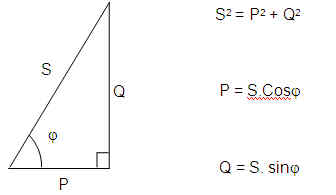What is power factor? and its meaning? Why should we increase the power factor cos phi ?
Power factor
The power transmitted from the source to the load always has two components: active power and reactive power. Active power characterizes the device’s ability to produce useful work, in W or kW. For example, the mechanical power (traction) of the engine. Reactive power does not produce useful work, but it is required for energy conversion, in VAR or kVAR units. It can be roughly understood as a magnetizing component, creating a magnetic field in the process of converting electrical energy into other forms of energy, or from electrical energy to electrical energy itself. The combined power for the above two types of power is called apparent power, VA or KVA units. The three types of power presented above have a close relationship with each other through the power triangle as shown below:

Significance of power factor In terms of power supply (generator or transformer). Apparently the same transformer capacity or generator power (in KVA). The higher the power factor, the higher the active power component and the more useful work the machine will produce. Someone will say “If so, why don’t we maintain cos phi ~ 1 for the generator or transformer to work efficiently”. The truth is how much power factor depends on the load (electrical device). The needs of the load’s active power and reactive power need to be met enough for the new load to work well. The more neutral solution is that the source will only provide a part of the reactive power to the load, the rest is missing, and the customer can retrofit by adding additional capacitors.
In terms of transmission lines, we are interested in the current flowing on the line. This current will heat the wire and create a voltage drop on the transmission line. If considered in a single-phase system, the apparent power is calculated by the formula: S=U*I If considered in a three-phase system, the apparent power is calculated by the formula: S=rad(3)U*I , U is the line voltage, I is the line current.
Both in single-phase and 3-phase grids show that the current is proportional to the apparent power S. The problem is that the apparent power is created by the two components of active and reactive power combined. From that, we have 2 comments: One is: if the same load, if we equip a capacitor to generate reactive power right at the load, the line only transmits the current of active power, then surely the line will be cooler. Second: If we accept the line to generate heat at the current level, and if we equip the capacitor to generate reactive power at the load, we can make the line load a little more than the current.
Above, the meaning of the power factor cos phi was presented. The following articles will present more meanings of increasing the power factor cos phi, analyze the need or not need compensation??? Please see also : Benefits of reactive power compensation

 0973.319.797
0973.319.797
 phuongnampanel@gmail.com
phuongnampanel@gmail.com




 vi
vi